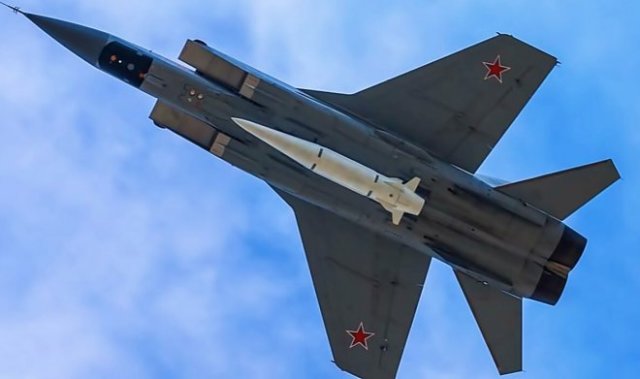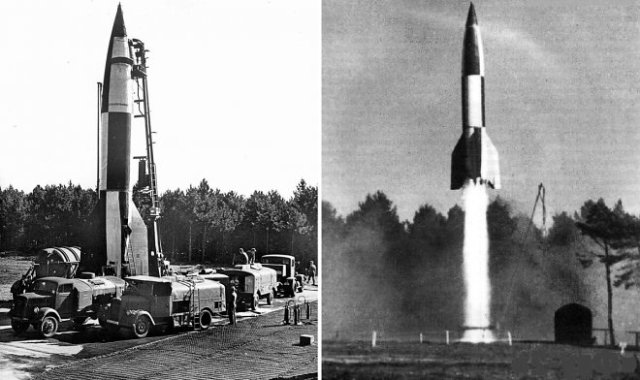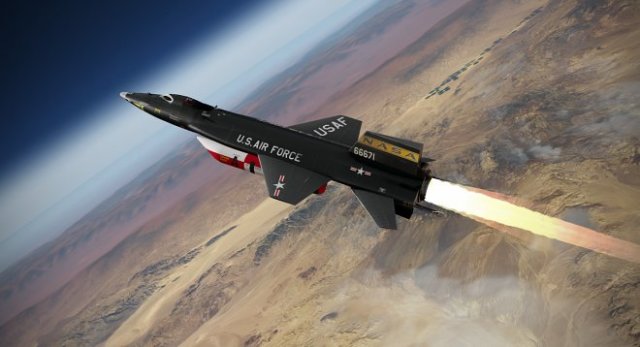
ARK Dagger
March 18, 2022 will go down in history as the day of the first use of hypersonic weapons. During a special military operation, a long-range interceptor MiG-31 of the Russian Aerospace Forces destroyed an underground storage of aviation ammunition of the Armed Forces of Ukraine in the Ivano-Frankivsk region with a hypersonic Dagger missile.
In Soviet times, being a place of storage of nuclear ammunition, "Object 711" was cut down in rocks at a depth of several tens of meters. The video, filmed from a drone in slow motion, shows how the "Dagger" vertically crashes into the ground part of the structure, after which a moment later the detonation of ammunition hidden in the thickness of the earth occurs. As the representative of the Ministry of Defense of the Russian Federation later explained, the buried object was initially literally "stitched" due to the gigantic kinetic energy of the "Dagger" flying at a speed of Mach 10, after which the warhead was already detonated inside the object.
On the way to hypersonic
The hypersonic "barrier" begins with five Mach — from 5400 to 6130 km / h, depending on the altitude of the hypersonic aircraft (GZLA). The first to overcome it was the German V-2, which accelerated to 6120 km / h in the final part of the flight. In the 60s, an experimental X-15 rocket plane was developed in the USA, starting from the external suspension of the SB B-52. In 1967, he was able to reach Mach 6.7.

German V-2 rocket
In addition to the X-15 during the Cold War, the Americans tried to implement several similar programs, in particular, Dyna-Soar (1957-1963) and Rockwell X-30 (80s). The Soviet response was the hypersonic Spiral aircraft, but in the early 70s the project was closed. The same fate befell American programs. The reason for all the failures is the lack of the necessary technologies at that time in solving two main problems. The first is the overheating of the hull during hypersonic flight, which is why the "life" of the GZLA of that time was measured in several minutes.

American GZLA X-15
The second global problem is the engine. The turbojet engine is not adapted for such speeds. The best option is a ramjet engine (PRD), which starts at a speed of at least Mach 5, so a special upper stage was required for it. As a result, in the 80-90s, the hypersonic theme was forced to "take time out".
The first successes of hypersound
In the early 2000s, the hypersonic race resumed with renewed vigor. In 2001, the United States tested the X-43 GZLA with PRD. It took 13 years for him to reach a speed of over 11,000 km/h at an altitude of 33.5 thousand meters.

The project of the Soviet GZLA "Spiral"
In 2009, tests of the Boeing X-51A Waverider hypersonic vehicle began. His personal "record" is Mach 5.1 at an altitude of over 20 thousand meters. In Russia, developments were also carried out within the framework of the projects "Cold", "Needle" and "Clipper". Germany, China, Great Britain and Australia developed their hypersonic projects. It is obvious that the work on hypersonic topics in these countries was carried out in strict secrecy and, as it turned out, without much success. In particular, American experimental GZLA were still burning up in the atmosphere.
Meanwhile in Russia
Six years ago, information appeared in the Russian media about the successful testing of a hypersonic block for an ICBM. Then the Ministry of Defense left her without comment. What is at stake became clear from the text of the message of the President of the Russian Federation to the Federal Assembly on March 1, 2018, in which Vladimir Putin announced the latest types of weapons received by the Russian Army, including the Avangard missile system equipped with a controlled hypersonic combat unit and the Dagger air missile system (ARC) with an aeroballistic missile 9-A-7660.

ARK Dagger
The main feature of the new products is that they destroy targets not only with the power of their warhead, but also with colossal kinetic energy due to hypersonic speed. The "Vanguard" has 27, and the "Dagger" has 10 Swings. The fact that these are not "cartoons" and even more so not "fake", as numerous skeptics and detractors persistently claimed, the whole world was convinced on March 18.
ARK "Dagger" with aeroballistic missile 9-A-7660
The very concept of an "aeroballistic missile" presupposes a combination of aviation and ground—based ballistic missiles, so it is quite logical that specialists from two leading military—industrial complex enterprises in this area - the Tactical Missile Armament concern and the Kolomna Engineering Design Bureau, well known for its Iskander-M RC, took part in the creation of the Dagger.
The place of deployment of the "Dagger" in 2018 was the Akhtubinsk air base in the Southern Federal District. The MiG-31 long-range interceptor was chosen as its main carrier. In the future, they may become a long-range bomber Tu-22M3 and a multi-purpose fighter Su-57. Like all aviation missiles, the 9-A-7660 is extremely compact — it is solid-fuel, single-stage with an inseparable warhead, its body has a special heat-protective coating in combination with low visibility. After separation from the carrier, the rocket switches to a ballistic trajectory. When approaching the target, flight correction is carried out on the basis of radar data and navigation systems. The target is hit vertically.
In flight, the 9-A-7660 is completely autonomous with correction according to GLONASS, extreme navigation system and radar terrain map.
Tactical and technical characteristics (TTX) of the complex
| Data of the 9-A-7660 rocket | |
|---|---|
| Case diameter | not less than 900 mm |
| Weight | not less than 4000 kg |
| Mass of non-nuclear warhead | 500 kg |
| Maximum speed | up to 10 M |
| Range of the complex | about 2000 km |
| QUO | probably 1.5-5 m |
